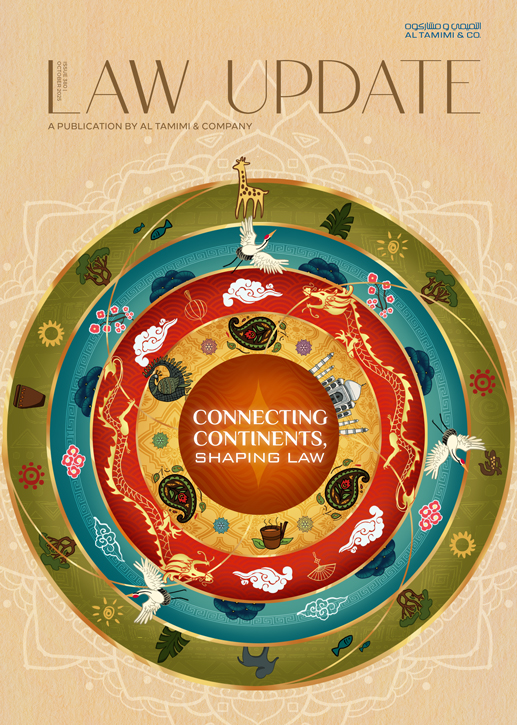- Arbitration
- Banking & Finance
- Capital Markets
- Commercial
- Competition
- Construction & Infrastructure
- Corporate / Mergers & Acquisitions
- Corporate Services
- Corporate Structuring
- Digital & Data
- Dispute Resolution
- Employment & Incentives
- Family Business & Private Wealth
- Innovation, Patents & Industrial Property (3IP)
- Insurance
Find a Lawyer
Book an appointment with us, or search the directory to find the right lawyer for you directly through the app.
Find out more
Africa & Asia
Connecting Continents, Shaping Law
This month, our focus turns to Africa and Asia, two regions reshaping global growth and investment. From Egypt’s ongoing legal and economic reforms and the strengthening of UAE–Moroccan relations, to the rise of Korean investment across the Middle East, this issue highlights the developments driving change across these markets.
We also explore the UAE’s role as a bridge between regions – a hub for private wealth management, dispute resolution, and cross-border collaboration, connecting businesses and investors across Africa and Asia. The articles in this edition offer practical insights into how these shifts are influencing trade, regulation, and market confidence across the wider region.


2025 is set to be a game-changer for the MENA region, with legal and regulatory shifts from 2024 continuing to reshape its economic landscape. Saudi Arabia, the UAE, Egypt, Iraq, Qatar, and Bahrain are all implementing groundbreaking reforms in sustainable financing, investment laws, labor regulations, and dispute resolution. As the region positions itself for deeper global integration, businesses must adapt to a rapidly evolving legal environment.
Our Eyes on 2025 publication provides essential insights and practical guidance on the key legal updates shaping the year ahead—equipping you with the knowledge to stay ahead in this dynamic market.
The leading law firm in the Middle East & North Africa region.
A complete spectrum of legal services across jurisdictions in the Middle East & North Africa.
-
Practices
- All Practices
- Banking & Finance
- Capital Markets
- Commercial
- Competition
- Construction & Infrastructure
- Corporate / Mergers & Acquisitions
- Corporate Services
- Corporate Structuring
-
Sectors
-
Country Groups
-
Client Solutions
Today's news and tomorrow's trends from around the region.
17 offices across the Middle East & North Africa.
Our Services
 Back
Back
-
Practices
- All Practices
- Banking & Finance
- Capital Markets
- Commercial
- Competition
- Construction & Infrastructure
- Corporate / Mergers & Acquisitions
- Corporate Services
- Corporate Structuring
- Digital & Data
- Dispute Resolution
- Employment & Incentives
- Family Business & Private Wealth
- Innovation, Patents & Industrial Property (3IP)
- Insurance
- Intellectual Property
- Legislative Drafting
- Private Client Services
- Private Equity
- Private Notary
- Projects
- Real Estate
- Regulatory
- Tax
- Turnaround, Restructuring & Insolvency
- Compliance, Investigations and White-Collar Crime
-
Sectors
-
Country Groups
-
Client Solutions
Oman’s Court of Investment and Commerce now in force
As of 1 October 2025, the Law of the Court of Investment and Commerce is in force, marking a decisive shift in how commercial and investment disputes are resolved in Oman. Established by Sultani Decree issued on 23 March 2025 and published in the Official Gazette on 6 April 2025, the Court sits under the Supreme Judicial Council and is headquartered in Muscat, with authority to establish primary and appellate circuits across the governorates. The reform’s message is clear: concentrate judicial expertise for business disputes, modernise procedure through a mandatory electronic platform, and deliver faster, more predictable outcomes that support investment and growth.
The Court’s institutional design signals seniority and focus. It is led by a president drawn from the higher judiciary, supported by a secretariat and a sufficient cadre of judges and administrators. Judges may be assigned from the Supreme Court, the courts of appeal, and the primary courts, and cases are heard either by panels of three or, in lower-value matters, by a single judge, with the most senior judge presiding in each circuit. A general assembly of the Court governs internal matters, such as how many circuits sit, how cases are distributed, and the scheduling of hearings, while a smaller committee ensures urgent administrative continuity during judicial holidays, with the Supreme Judicial Council maintaining oversight to ensure coherence and quality.
Jurisdictionally, the Court is now the specialist forum for the core of Oman’s business and investment life. With administrative, labour, and rental disputes carved out, the Court exercises exclusive competence where at least one party is a merchant and the dispute relates to commercial business, and it also captures conflicts arising from investment contracts. Within that frame sit the disputes that most often drive corporate risk: disagreements among shareholders and partners (including those involving listed joint stock companies), issues tied to commercial assets, banking and securities disputes, insurance and finance matters, insolvency and restructuring, arbitration-related applications, intellectual property and trade secrets, competition enforcement and practices harmful to national products in international trade, electronic commercial transactions, public-private partnership contracts, and specified maritime purchase disputes. The practical effect is consolidation: rather than fragmenting commercial disputes across forums, the market now has a single court designed for them.
Procedurally, the Court is digital-first. A dedicated electronic system underpins the entire life-cycle of a case: filing of claims and requests, payment of fees, service of process, submission of pleadings and exhibits, lodging of expert reports, and even appearances by secure video. A Lawsuit Preparation Office, led by a judge and supported by administrators and, where necessary, external experts, scrutinises each new case within days to confirm that fees are paid, parties are properly identified and locatable, documents are complete and translated into Arabic where required, and witnesses and their contact details are identified if testimony will be needed. Defendants file electronically within short, fixed windows; claimants may reply and defendants may answer that reply within similarly defined periods. After those windows close, no new memoranda, documents, or claims may be introduced unless the Court is satisfied that serious reasons justify an exception, and any permission comes with strict deadlines.
The hearing stage is equally disciplined. Once preparation closes, the file is referred electronically to the competent circuit. The circuit may dispose of the matter by a provisional judgment on the papers within a defined number of days or fix a hearing date within a short period. In all cases, the circuit must decide the lawsuit within ninety days of referral, with only a limited extension available where serious reasons exist. Adjournments are constrained: the same reason cannot justify more than one postponement, and any postponement is brief. The Court may direct parties to supply specific documents or data within set periods and can connect with parties, representatives, witnesses, or experts by verified video where appropriate. Expert evidence can be front-loaded by the parties; if the Court appoints an expert, it sets a strict timetable for the report and allows measured opportunities for responses. This structure encourages early, complete presentation of the case, discourages tactical delay, and gives businesses a timetable they can plan against.
Enforcement is treated as a judicial service in its own right. An enforcement judge supervises execution, decides disputes arising in enforcement, and issues related orders and decisions. Challenges to enforcement decisions go to the Court’s appeal circuits and are final at that level. Debtors can view enforcement requests electronically, see the amounts due, and pay through the same platform; when payment fully satisfies the judgment, the system automatically cancels the orders and decisions issued against the debtor. In practical terms, the Court’s work continues until judgments translate into performance, not merely until reasons are written, a design choice that aligns with lender and investor expectations about the credibility of court outcomes.
Two operational points call for immediate attention from companies and financiers. First, service to the address recorded in the civil-status registry or the commercial register is deemed service to the person and produces full legal effect. That makes it essential to keep registry entries current and to monitor the e-portal consistently. Second, because filings run through an electronic platform and translations into Arabic are required for foreign-language materials, in-house teams should build translation workflows into transaction closings and contract management so that, if a dispute arises, filings are not slowed by translation gaps. The same applies to expert evidence and witnesses: the preparation office will ask early for names, contact details, and summaries of testimony, so it is prudent to assemble those building blocks well before litigation is initiated.
The Court of Investment and Commerce reshapes dispute resolution in Oman by centralising commercial jurisdiction, imposing disciplined timelines, and digitising end-to-end procedure and enforcement. Businesses and financiers should act now to align internal processes with the Court’s fast, document-driven model.
How can we help?
For more information on the above alert, feel free to contact the key contacts.
Key Contacts
Stay updated
To learn more about our services and get the latest legal insights from across the Middle East and North Africa region, click on the link below.


